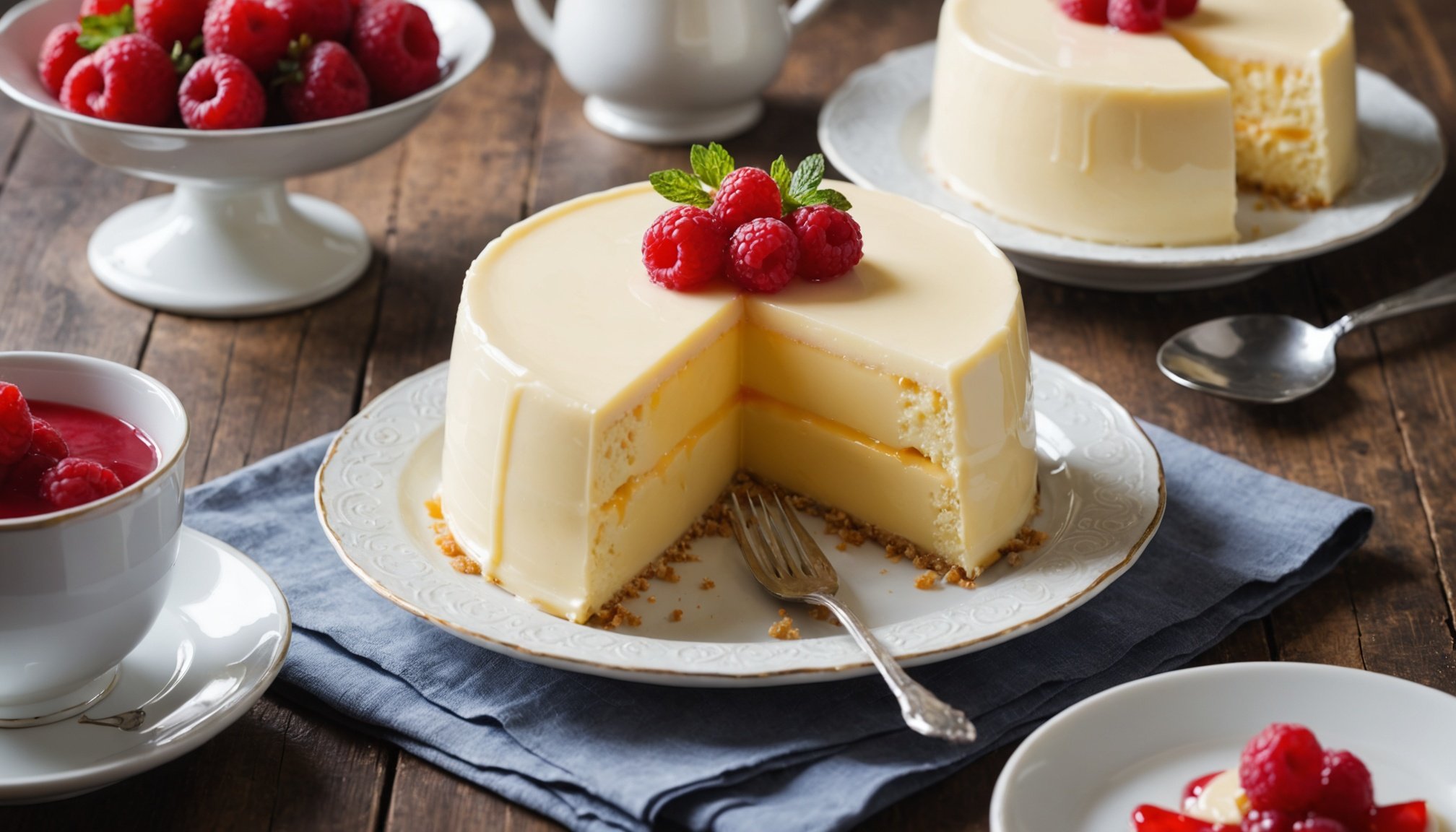Understanding English Blancmange
English blancmange is a silky, smooth dessert with a long-standing presence in culinary traditions. Identifiable by its creamy texture, this dessert has played a crucial role in the evolution of European and specifically, English dessert history. Blancmange, derived from the French term for “white dish,” has origins dating back to the Middle Ages. Originally, it was a savoury dish comprising chicken, almond milk, and rice, but evolved into the sweet treat we know today.
While similar to other desserts like panna cotta and Bavarian cream, blancmange distinguishes itself through its use of ingredients and cultural variations. Panna cotta primarily uses gelatin, whereas blancmange traditionally incorporates cream and often uses cornstarch or gelatin, allowing for a firmer set. Bavarian cream, meanwhile, features an added element of custard base, offering a richer texture.
This might interest you : Perfecting the Classic British Sunday Roast: The Comprehensive Guide to Flavorful Excellence and Scrumptious Sides!
Different regions have infused their unique flair into blancmange. British versions often include milk and cream for a luxurious mouthfeel, with subtle hints of flavor from almond or vanilla. Caribbean variations might incorporate coconut milk or fruit purees for a tropical twist. Mixing tradition with creativity, blancmange has adapted over time, continuing to delight palates across the globe.
Ingredients for Ultra-Creamy English Blancmange
Creating an ultra-creamy English blancmange begins with carefully selecting the right blancmange ingredients. The choice and ratio of milk and cream are pivotal in achieving the dessert’s desired luxurious mouthfeel. The traditional recipe primarily calls for whole milk and double cream to ensure a rich and smooth consistency. Using these high-fat dairy products imbues the dessert with its characteristic silkiness.
Topic to read : Perfecting the Classic British Sunday Roast: The Comprehensive Guide to Flavorful Excellence and Scrumptious Sides!
In addition to the milk and cream, the perfect blancmange requires a setting agent, often cornstarch or gelatin. While cornstarch provides a firmer texture, gelatin can give a slightly more wobbly finish, depending on preference. Balancing these components allows for a delightful texture that holds its shape without compromising creaminess.
Flavoring is where personal creativity comes into play. Traditional options include subtle hints of vanilla or almond extract. Both add delicate flavor profiles that complement the creamy base without overwhelming it. For those wishing to experiment, a splash of rosewater or citrus zest can infuse zesty undertones, enhancing the dessert’s complexity.
By thoughtfully combining these elements, anyone can craft a blancmange that is not only smooth and creamy but also flavourfully enticing.
Step-by-Step Recipe for English Blancmange
Mastering the blancmange recipe involves attention to cooking instructions and meticulous preparation. Follow these phases for a delightful dessert.
Preparing the Base
Start by heating whole milk and double cream in a saucepan. Stir gently to avoid scorching the cream. Watch the mixture closely until it begins to steam, then reduce the heat. While the milk and cream heat up, in a separate bowl, dissolve cornstarch in a small amount of cold milk, stirring until smooth.
Combining Ingredients
Once the milk mixture steams, gradually add the dissolved cornstarch. Continuously whisk to ensure a lump-free texture. Stir in sugar and your choice of flavouring, like vanilla or almond extract, as the mixture thickens. Keep stirring until it forms a smooth, consistent base.
Chilling and Setting the Blancmange
Pour the prepared mixture into molds or serving dishes. Allow them to cool slightly at room temperature before refrigerating for at least four hours. Proper chilling and time management are crucial to achieve a perfectly set blancmange.
These cooking instructions guide you step-by-step to create a beautifully smooth blancmange ready for serving. Enjoy crafting this historical dessert with ease and confidence.
Tips for Achieving Desired Creaminess
Achieving the perfect creamy texture in a blancmange is imperative for a delightful dessert experience. Several cooking tips can guide you towards this lush consistency, beginning with understanding the role of each ingredient. Milk and cream are your main players. Adjust the ratios according to your desired richness; more cream means smoother texture but also increased richness.
When incorporating culinary techniques, be vigilant with your mixing. Constant stirring during the cooking process avoids unwanted lumps, achieving a smoother finish. Consider using a fine mesh strainer when pouring the mixture into molds to ensure an even texture.
Avoid common pitfalls such as overheating, which can cause ingredients to separate and thus impact the desired creaminess. Gentle simmering rather than boiling helps maintain the ingredients’ integrity.
Adapting to personal taste is also crucial. If a richer texture is preferred, swap more of the milk for additional cream. Conversely, to lighten the dessert, increase the milk proportion. With these insights, you can craft a blancmange that fulfills your quest for the ideal creamy indulgence.
Variations and Flavor Suggestions
Blancmange variations offer an exciting opportunity to customise this beloved dessert, enhancing both flavour and presentation. One popular adaptation is the fruit-infused blancmange, where fresh fruit purées such as strawberry or raspberry are incorporated, lending both colour and a burst of natural sweetness. This approach not only adds visual appeal but also aligns with seasonal availability, making it a versatile dessert choice.
Another intriguing avenue is to incorporate chocolate for a decadently rich chocolate blancmange. This variation introduces a layer of indulgence and pairs well with subtle hints of almond or vanilla essence to complement the chocolate’s deep tones. The balance of flavours can be tailored to match personal preferences, making each creation uniquely delightful.
For those inclined towards savoury-sweet combinations, infusing herbs like lavender or spices such as cinnamon can evoke a sophisticated taste profile.
Serving suggestions can further enhance the dessert’s appeal. Consider garnishing with sliced fruits, a drizzle of fruit coulis, or delicate chocolate shavings. By exploring these flavour ideas and customising your blancmange, you create a dessert that not only satisfies the palate but also captivates the senses through dessert customization.
Troubleshooting Common Issues
Creating the perfect blancmange can be challenging, with common cooking problems sometimes interrupting the path to dessert perfection. One frequent issue is the lumpiness of the mix. To prevent this, ensure that the cornstarch is fully dissolved in a cold liquid before adding it to the warm milk and cream. Constant whisking while combining prevents lumps from forming.
Another typical dessert issue is failure to set firmly. This can occur if the proportions of cornstarch or gelatin are incorrect. Always measure accurately and consider environmental factors such as humidity that may affect setting time. For an alternative fixing step, gently heat the mixture again before chilling and setting. This often provides the necessary cohesion needed for proper setting.
If your blancmange develops an unintended flavour, it could be due to burned ingredients. To tackle this, maintain a low simmer and keep stirring throughout the cooking process.
By understanding these cooking solutions and applying them diligently, one can significantly enhance the success rate of crafting a flawless blancmange. Through adopting preventive measures, individuals can anticipate a smoother preparation process and a delightful final dish.
Historical Context and Serving Suggestions
Blancmange has carved a significant place in English cuisine history, dating back to the Middle Ages. Initially a savoury meal combining chicken and almond milk, it mirrored the evolution of culinary styles by transforming into the delightful dessert we cherish today. Appreciated for its simplicity and elegance, blancmange became emblematic of European culinary refinement.
When presenting blancmange, creativity flourishes. Consider serving it with a delicate sauce, such as raspberry coulis or lemon curd, to introduce contrasting flavours. Innovative garnishes can elevate the visual appeal. For example, edible flowers or finely chopped pistachios create an attractive presentation, adding a pop of colour and texture.
For a sophisticated dining experience, pair blancmange with complementary beverages. A crisp white wine or a fragrant herbal tea serves as a perfect match, balancing the dessert’s creamy richness with refreshing undertones.
Whether hosting a formal gathering or enjoying a casual treat, arranging ingredients thoughtfully enhances blancmange’s aesthetic and taste. These serving ideas not only captivate the senses but also highlight the dessert’s historical sophistication, making every occasion memorable.




